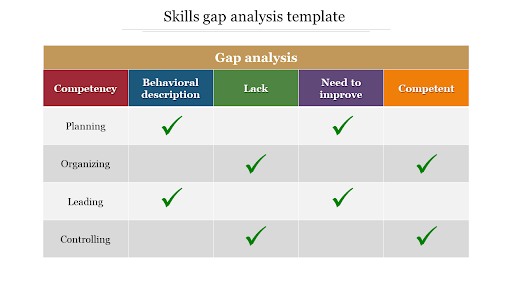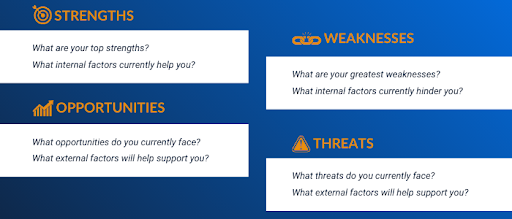Skills Gap Analysis 101 For New Managers: Identify Skills Gaps, Perform an Analysis
Performing a skills gap analysis is crucial as soon as you become a new manager.
You’re now in charge of your own team. Congratulations! Is your natural instinct telling you that you can guide your team to greatness using your own management skills?
You’re not alone. Many new managers we train at Krauthammer have a similar mindset.
But as a manager, you can’t really guide your team if you don’t know first what your team is capable of.
Without this understanding, you run the risk of either:
- not pushing your team to their full potential,
- pushing your team beyond their limits.
Neither of these situations is likely to result in the development of a strong team that delivers on your KPIs and metrics of success.
But don’t worry – you’re not the first new manager to feel confused about how to guide your team from where they are now to where they need to be. And you definitely won’t be the last.
Guiding your team is a process that requires you to shift your mindset and gather the right tools at your disposal. Lucky for you, we’ve got just the tool for you today.
What is a skills gap analysis?
A skills gap analysis is a method you can leverage like a roadmap to visualize your journey to success. It will help you bridge any gaps in your team’s knowledge that are delaying them from reaching their goals.
A skills gap analysis helps you understand what skills are missing in your team’s current talent pool. This means a skills gap analysis can provide you with two crucial things:
- A clear overview of what your team is currently able to achieve with their existing skillsets and experiences.
- A list of the additional skills and experiences that are essential for meeting the targets set by the board.
The technique allows for any discrepancies between the two to be addressed efficiently and effectively. 
Source
In short, performing a skills gap analysis will help you identify the skills you need to meet your yearly objectives, ensuring you have the right skills, in the right place, at the right time to deliver excellent results and satisfy your superiors.
As a new manager, you should perform a skills gap analysis straight away.
Why is a skills gap analysis necessary for new managers?
McKinsey reports that 87% of businesses feel that they are currently facing a skills gap, or will develop one within the next five years. Skills gaps within teams are – as I’m sure you’re aware of by now – very common.
According to research firm PwC, a lack of skills can result in:
- An inability for teams to effectively innovate
- A loss of market opportunities
- Missed growth targets
- Delayed initiatives.
There are three reasons why skills gaps in teams can occur:
- Emergence of new skills as a result of the implementation of new technologies
- Evolution of existing skills as businesses embrace new ways of working
- Expiration of outdated skills that are not in demand in modern organizations
These three areas are crucial to the future of work. So while it’s important to understand who in your team is lacking the skills to compete in these areas, it’s also crucial to perform a skills gap analysis on yourself.
Personal skills gap analysis
Gartner Analyst Mark P McDonald noted that leaders today must be artists. Meaning, that they should have the ability to adapt rapidly in a world of work where a talent to ‘relate, create, and instigate change’ defines overall success.
- Relate: Leaders need to make a shift from production-based management to people-centric management, relating with teams to better drive performance.
- Create: Leaders need to create new ways of working and introduce new processes that redefine standards and generate strategies that work today.
- Instigate change: Leaders need to be at the forefront of change, actively introducing new processes and motivating teams to accept change.
After performing a skills gap analysis on yourself and your team, you’ll be able to pinpoint exactly where you have opportunities for improvement.
This will take you from a manager to a leader and all-round coach, which is our goal at Krauthammer – to bring out your best by training your mindset and transforming your behavior.
Imagine you’re a basketball trainer.
Would you rather come up with game plays that may or may not work for the team and then direct them from the sidelines as soon as they step on the court?
Or would you rather optimize your game plays for the skillset on your team? And then continue to improve your foundation based on how the individuals perform said play?
It’s a no-brainer.
With all behavior change, this shift of leadership mindset starts with you.
But don’t just take this from us. One of our Krauthammer trainees suggested that after a Krauthammer training,
“[Krauthammer training] taught me to develop my colleagues and accompany them in their professional development. I learned that we need to overcome inertia when obtaining results linked to objectives. Both are things I’ve now adapted from the training into my management style.” – Krauthammer trainee Sebastien Rey
Performing a skill gap analysis early on in your managerial career is key to developing a strong and successful team.
How to perform a skills gap analysis in 3 steps
There’s no right or wrong way to conduct a skill gap analysis. But keep in mind your approach should be tailored to the needs of your team and business objectives, especially if you’re keen to generate useful insight.
However, there are three questions you should always ask: Who, What, and Where.
- Who?
Which members of your team do you want to analyze?
Your strategy may include everyone due to the scale of different personality types in your team, or just those working on a specific project, or within a specific area.
The gap you’re looking to close will determine who you want to choose. It’s also important to consider how you’ll gather the data you need.
For example,
- Do you want to consider your own experience with the individual or a past manager’s experience?
- Do you want to perform assessments and self-assessments?
- Do you want to look at HR documentation and monitored performance?
You’re the boss – it’s up to you to make data-driven decisions for the good of your skills gap analysis.
- What?
Now, forget about your team. You heard that right. Imagine you don’t have a team to begin with and you’re actually hiring from scratch.
- What sort of roles would you recruit for?
- What sort of skills would you need to bring on board to help achieve your goals?
- How can you build a good team culture to ensure productivity, efficiency and a smart use of resources?
It may even be useful to draft up some mock job adverts here. Talk to HR to see how they would go about hiring someone. Visualize what's important to you as a behavioral trick to manifest your intentions.
With leadership training under your belt, you’ll know what kinds of personality types go together. Krauthammer can help you identify these personalities.
What talents are most likely to have the biggest impact on your way of working?
Answering these questions in a structured, formalized way will help you have an idea of where your team needs to be.
- How?
The third step is to analyze the data that you’ve collected from steps one and two and look at how they compare.
- Are the existing skills of your team in line with the talents you need to succeed or are there notable gaps between them?
- Where are these gaps, and what key talents are you currently missing that you could implement in the future?
The ‘how’ stage of the skill gap analysis should provide you with the insight you need to take action, introduce change, and, most important, find the right training for your staff.
Remember, as a new manager a personal skills gap analysis is just as beneficial. So you may be thinking it’s time to participate in some leadership online courses yourself.
After all, as Krauthammer consultant Fotigui Camara says,
“Leadership is all about engaging and motivating others.”
Without the right mindset yourself, how do you hope to help others? Developing self-confidence and optimism yourself will be reflected in the team you build.
How do you take action from your skills gap analysis data?
After you identify the Who, What, and How, your next plan of action is to actually carry out a skills gap analysis. By reviewing the strengths and weaknesses of your team, you can now reallocate skills to boost these strengths while minimizing the weaknesses you spotted.
However, you can also leverage the data and insights that you’ve uncovered to optimize your approach to ensure top outcomes.
1. Identify what’s working- Learn from what’s already working within your team.
- Borrow lessons from success and apply these lessons to underperforming areas.
- Transition team members from high-performing areas to those that are struggling and would benefit from extra support.
- In underperforming areas, consider bringing in those with adjacent skills (those skills that do not 100% bridge the gap, but which reallocate those that possess relevant and associated talents to breathe new life into these tasks). External hiring, for instance, or leveraging the help of freelancers or consultants.
- Consider bringing new skills into this area, and repositioning team members with the necessary skills to ensure that you are deriving the most value from your efforts. Reskilling can also be an effective solution to this particular problem.
Team gap analysis: Why is reskilling important?
For the majority of managers, the solution to bridging the skills gap is to rehire. In fact, across Europe, McKinsey reports that 67% of businesses look to hire the skills they need, while a smaller 61% consider reskilling.
As a new manager, it’s important to understand just how important reskilling is to bridge the gap.
Let’s go back to imagining you’re a basketball coach. Do you think it’s more valuable to change a strong rookie for a LeBron James?
Or are you better off investing in your rookie with training and reskilling? Financially, this is the smarter way to go. But it also reasserts trust in the team you have, while ensuring you can keep an employee for much longer on your team.
To support this, McKinsey reports that reskilling over rehiring:
- Boosts employee satisfaction,
- Elevates the end-customer’s experience
- Makes internal promotions more likely
- Boosts internal and external brand perception
- Optimizes employee retention
- Overall contributes to your organization’s bottom-line growth
Reskilling through necessary training courses and learning opportunities positions you as a leader who is responsible for your team. Someone who cares about its success, and is willing to do what’s needed to develop your people both personally and professionally to drive success and generate impressive results.
Here are some ideas to start reskilling:
- Leverage online courses
- Share educational material
- Give individuals opportunities to network and learn from other company peers
- Give opportunities to attend conferences
- See what kinds of diplomas are out there that they can obtain
- Generate a continuous feedback loop between your team and you
- Always touch base with your employees to see how they’re coping and what their needs are
Key takeaways
As a new manager, we’re well aware that it takes time to go from ‘one of the guys’ to someone in a respected managerial position.
And while there may be a degree of discomfort to it, it’s a necessary transition – one that a personal skills gap analysis will help you with.
The most important takeaways here are:
- A skills gap analysis will help you identify the strengths and weaknesses of your team
- A personal skills gap analysis is crucial to perform as a new manager
- You should carry out a skills gap analysis as soon as you are hired as a new manager
- Reskilling is more valuable than rehiring


